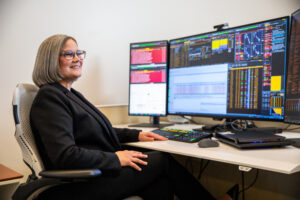Melissa Hinmon’s extensive experience in the industry has taught her many life lessons that make her the successful director of equity trading at Glenmede Investment Management that she is today. One of the results of these experiences has been several nominations and a subsequent win at Leaders in Trading New York 2024, where she took home the award for Buy-side Market Structure Expert of the Year.
 Hinmon has a career history that spans nearly four decades, with the last 10 years spent at her current firm. Originally joining Glenmede in 2015 as an equity trader, she took on her role heading up the buy-side firm’s equities trading business in 2017.
Hinmon has a career history that spans nearly four decades, with the last 10 years spent at her current firm. Originally joining Glenmede in 2015 as an equity trader, she took on her role heading up the buy-side firm’s equities trading business in 2017.
Originally joining the industry as a runner on the trading floor of NYSE Chicago – formerly known as the Midwest Stock Exchange, her career was nothing short of a baptism of fire, igniting a passion for the markets that would lead to her current seat today.
“It was electrifying [seeing] the energy people had and the interest in the companies where stocks were trading. I ran to the bookstore within the first week of working on the exchange and I bought books on the market like ‘Inside the Fed’ and ‘a Barron’s guide to financial definitions’, and I just ate it all up,” she explains.
“S&P used to publish this tiny thing called a tear guide, and the paper was super thin, like airmail paper. I managed to get my hands on one and I took it home over the weekend and I memorised every stock ticker and which specialist traded it on the floor, and what post they were at so I could come armed and know exactly where to run a ticket to or from.
“The more interested I became, the more people became interested in me because I started asking questions.”
Not all traders will have the opportunity to witness the exhilaration of an open outcry trading floor during their career. In the past, the majority of trading has taken place in-person on a trading floor where traders in the flesh would buy and sell throughout the course of the day, and where runners – such as Hinmon – would run between them delivering tickets.
However, given the rising prowess of technology in trading, the way markets today operate has changed beyond recognition. Importantly, stresses Hinmon, so too has the way that traders feel markets and the methods that they use to anticipate movements. With greater electronification and fragmentation, it is sometimes harder to see the entire picture and this poses a new challenge for those starting out in the industry.
“It [activity on the trading floor] was like a freight train coming. You could feel the rumbling in the tracks. Especially on the New York floor, you can hear the footsteps,” she says.
“You could feel the vibration of people walking faster, and you can hear the momentum pick up. It was really fascinating to me because then your ears would perk up and you’re thinking ‘what do I need to pay attention to?’ ‘What’s happening right now?’ Now, you lose that continuity. It’s all machine-driven. There was a certain psychology that you could feel when people moved that markets lack now.”
Mentors
Hinmon stresses the importance of mentors when asked what has had the greatest impact on her career to date. It’s these relationships that have led her to her current seat, driven by her own desire to keeping asking questions and learning. It was when she was first working on the Midwest floor that she began to become interested in other areas of the markets.
“I went to the head of derivatives and said, ‘could you please explain to me why you’re trading this stock and what it is for?’ He ended up having me come over for an hour a week to sit with his team to learn what he did and why.
 “Relevance is important in any business but even more so with the shifts that we see in ours and the constant changes with regulation, product, algorithms, exchanges and trading venues. You have to understand how they function, why they function and what’s the best route for you and your team to accomplish what your portfolio managers’ goals are.
“Relevance is important in any business but even more so with the shifts that we see in ours and the constant changes with regulation, product, algorithms, exchanges and trading venues. You have to understand how they function, why they function and what’s the best route for you and your team to accomplish what your portfolio managers’ goals are.
“What may be important last week is less important this week. It may be on the front burner and then that flame goes out. It’s a game of chess.”
Cultivating and respecting relationships is a key mantra she suggests all new traders should follow. When asked what other tips and tricks she would recommend to those starting out in the trading industry, Hinmon highlights some of the most important lessons she’s learnt are remaining fluid, rolling with the punches and learning to admit when you’re wrong.
“Young traders have to recognise that the market is bigger than you are. You have to be willing to admit when you’re wrong. We’ve lived through a lot of different crises. The flash crash, the great financial crisis, Brexit, Russia, and looking back one thing you realise is just as markets don’t go up forever, they don’t go down forever,” she explains.
“If there’s been one thing I’ve learnt, it is that markets recover. They are living, breathing creatures. They have peaks and valleys. Don’t get too rattled when we have drawdowns in the market. Own up to your mistakes and learn from them. I had some pretty big errors back in the day. Whether it was a matter of trying to be too quick on something or flat out doing something wrong, own up to it and learn from it. People respect you more when you do that.”
US fragmentation
Hinmon, who sits on both the SIP and CAT (Consolidated Audit Trail) advisory boards among others, took home the Buy-side Market Structure Expert of the Year Award at Leaders in Trading New York 2024 after multiple industry nominations by peers and clients. The Philadelphia-based director of equity trading confirms she is increasingly keeping tabs on market fragmentation in the US. This, she explains, is one of the market structure themes having the greatest impact on the US equities landscape today.
Fragmentation is no new phenomena in Europe which has three times the number of exchanges as the US, 10 times the number of listing venues and 20 times as many post-trade providers and is an issue that comes up time and time again in the ongoing debate around the health of the liquidity landscape in the region.
Read more – The TRADE announces Leaders in Trading New York 2024 award winners
However, as noted by Hinmon and other market structure specialists, thanks to the launch of new national exchanges, the proliferation of private rooms within venues and the growth of the single dealer, bilateral and off-exchange segments, the US market has become fragmented to the point that many market structure experts are keeping a watchful eye to see how it further develops.
Private rooms have taken off in the US in the last year. Currently the concept – whereby a venue offers a select number of participants the opportunity to create a closed pool where they can interact with one another – is not permitted under EU regulation. However, in the US, as the number of venues increases, so too does the opportunity to fragment things further through more private rooms.
“What will the consequences be of the launch of the four or five new national exchanges?” asks Hinmon. “We already have 16. What does it look like if we have 21? That’s a big deal. It’s something that hasn’t been corrected in years.”
In making her point, the director of equity trading quotes several market structure sell-side partners that have all published data in recent months unpacking the ongoing theme of fragmentation, and what is and is not addressable for US traders.
 Among the names is Jenny Hadiaris at Citi. According to Hadiaris, just over 25% of total market volume in the US in 2024 was addressable single-stock liquidity for institutional investors if ETF, sub $5 stock, market making and some wholesale retail activity is removed from the equation.
Among the names is Jenny Hadiaris at Citi. According to Hadiaris, just over 25% of total market volume in the US in 2024 was addressable single-stock liquidity for institutional investors if ETF, sub $5 stock, market making and some wholesale retail activity is removed from the equation.
“It needs to be corrected. I don’t know what the solution is. If I could come up with the solution, I’d probably be able to retire tomorrow,” says Hinmon.
The increased fragmentation is also causing trading flow to become increasingly siloed to a certain number of asset managers dependant on where certain relationships lie, and this is contributing to changes in the buy-side competitive landscape.
“At some point in time, we’re going to be left with maybe eight or nine asset managers in the country. Is that really what we want? The market is becoming increasingly fragmented through bilateral trading agreements the proliferation of private rooms and single dealer platforms. If a select few are getting access to liquidity that others are not, how can we really say there is price discovery in our markets?”
The issue, Hinmon highlights, is the lack of transparency in the US as new venues and forms of trading continuously expand the competitive landscape. If volumes are becoming increasingly siloed into less transparent corners of the market that often do not print on the SIP, traders are faced with a greater challenge when looking to be executed in the market.
Data released by Jefferies’ Anna Kurzrok in a market note to clients found that in November last year, off-exchange volume exceeded 50% on 12 out of the 20 trading days, and on almost all of the trading days in December.
Segmented markets mean there is often less liquidity than an institutional trader might think, posing a challenge for those trying to navigate the execution of their orders. When exploring the growing off-exchange and bilateral segments, Hinmon highlights that this trend is not limited to smaller retail flow.
Quoting data released by Nasdaq’s Phil Mackintosh, she explains that looking at all stocks in the Russell 3000 Index, very few now have off-exchange share below 30%. In fact, the majority are now seeing off-exchange trading range between 40%-50% regardless of stock price or market cap.
When asked what the institutional buy-side can do to navigate this increasingly complex and shrouded landscape, Hinmon confirms that her team rely heavily on their transaction cost analysis (TCA) both internally and externally.
The situation is likely only set to be exacerbated by recent developments in the US that will see equities move to a 24 hour, five day a week model. There are several platform providers such as OTC Markets and Blue Ocean Technologies offering after hours US trading but in recent months the US market has also seen moves from central venues such as NYSE, Cboe, and Nasdaq, all looking to expand some or all of their equities books onto an extended trading hours model.
While the moves have glaring positives such as increased flexibility on trading and greater exposure to other regions around the world, an extended trading period for equities also poses some questions around transparency, operations and retail. Questions that those sitting in Hinmon’s seat must now begin to assess as the markets evolve further.
“What’s that [24/5 equities trading] going to look like?” asks Hinmon. “I can’t imagine institutions are going to be playing that. What’s the advantages for retail playing that? Is it going to cause additional retail fragmentation. Is retail participation going to be elevated?”
Other market structure developments Hinmon is keeping tabs on include the potential for the new administration to do away with the order protection rule (OPR), the expansion of institutional cryptocurrency trading, and whether the US Securities and Exchange Commission (SEC) is going to approve exemptive relief for ETF mutual fund classes.
While there are many potential plates spinning, Hinmon explains that she and many like her are for the time being waiting for the dust to settle following the election in November and subsequent change in administration in the US that took place at the start of this year.
Hinmon, like many in her trade, has learnt that success in this industry follows adaptability. While market structure and regulatory change in the US is currently somewhat dormant, it’s more than likely that with the change of administration witnessed at the start of this year, there is scope for a wide breadth of changes to be made that will echo through North America and into the markets globally. For those less clued up than Hinmon, it’ll likely be a bumpy ride.